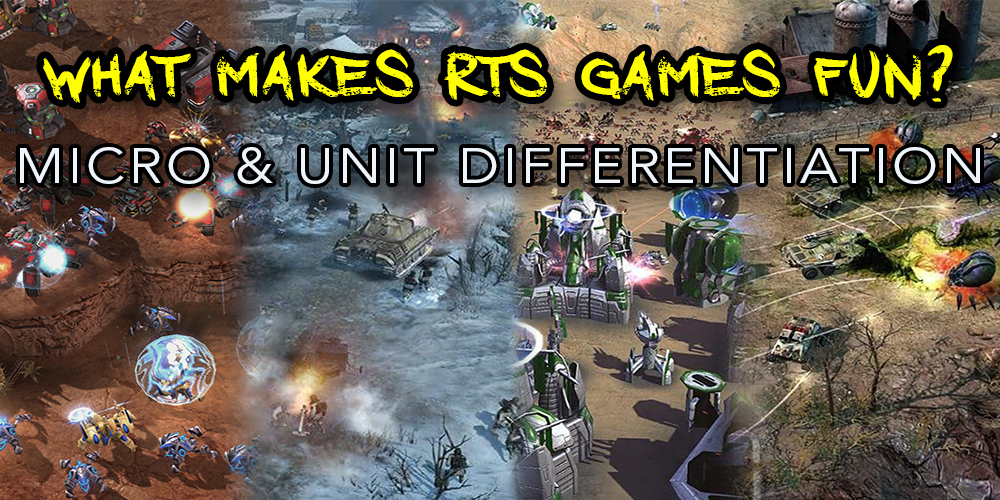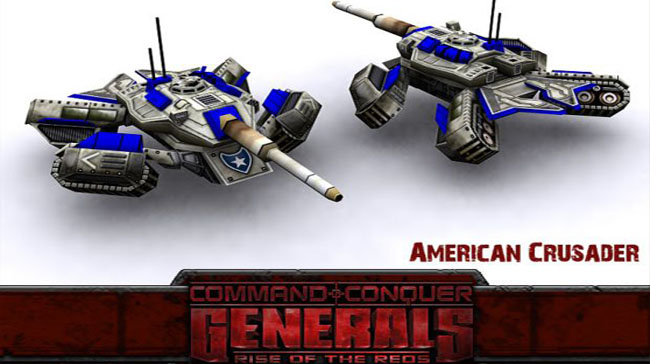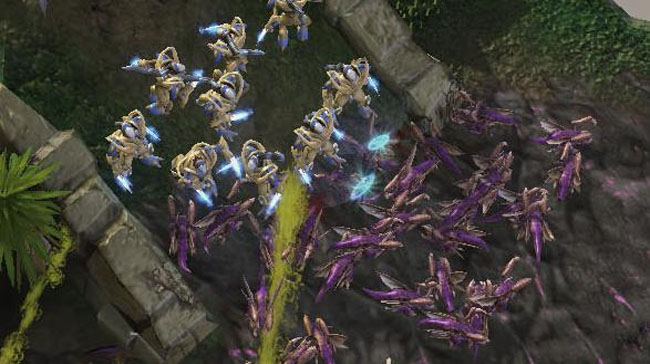
In RTS Games, there’s going to be a lot of different units. To keep the game compelling, controlling each unit needs to feel unique and nuanced. Designing units around how they feel to the player and ensuring unit variation should be a priority in RTS games; else it will seem bland and fail to engage players.
Let’s pretend we’re making an RTS game that has four types of units: infantry, tanks, motorbikes and aircraft. They’ll certainly look different to each other, but how do we make them feel different? Each unit type should be assigned different properties that determine how players control them. Motorbikes would be fast but weak, and unable to reverse or turn on the spot. Infantry would be small and numerous, leaving them vulnerable to area of effect, while air units might need to re-arm from an airfield. Tanks are a generic unit, so they’re a bit trickier to make interesting. Unless… we make them hover tanks! This will allow them to traverse over water but have a slow acceleration and deceleration.

Then we should give our units additional utility; tanks could crush infantry, air units could have bonus sight range for scouting, infantry could capture structures, and motorbikes could be too fast for certain projectiles. You can see how they’re not just four random units types anymore; they are starting to develop their own personality. Controlling tanks would be about formations and targeting while controlling infantry is about avoiding explosives and dodging crushes and using motorbikes is about harassment and avoiding upfront engagements. When different unit types require different types of micro, it keeps the player on edge and makes an RTS game compelling. Company of Heroes is so fun to play because it varies from charging hordes of Conscripts, to cloaking sniper teams and flanking with tank destroyers.
Once unit types are defined, individual units need to be distinguishable from each other. Since RTS games have multiple factions, there’s generally going to units that perform the same role or a similar function. Units can be distinguished in various ways such as quirks, abilities, additional utility, or just general modifications to the stats, so long as it works with the game mechanics to provide a different experience.

Zerglings feel so different to Zealots because Zerglings are about surrounding your opponents to prevent kiting, which works well with the pacing and the chokepoint centric map design of StarCraft. Riflemen and Volksgrenadiers are distinct because of their ranges of effectiveness, which becomes complex when it ties into Company of Heroes’ mechanics of cover and flanking. The mechanics of the game need to blend with the characteristics and quirks of the units. Weaker rear armour is an integral part of Company of Heroes, but it just isn’t appropriate for a Terran Seige Tank or Ultralisk, the scale and unit lethality found in StarCraft would make it redundant.
Micro techniques should be a reflection of the unit’s aesthetics; you would expect a Laser Tank to control differently than a Flame Tank. In Command and Conquer Generals, a Gatling Tank can attack the ground for a few seconds to “spin up” and increase its rate of fire. Does that make sense? Yeah, sure, it is armed with a Gatling cannon, after all. How about a grenade launcher speeding up its rate of fire over time, does that make sense? No, not really. Instead, the grenade launcher should have a powerful area of effect, but with a short fuse that can be dodged by the opponent. Intuitive design accelerates the learning curve by making these type of characteristics easier to identify and remember.

Additionally, micro techniques and abilities should be thematic to the faction they belong to, something that Generals does brilliantly. The Chinese Faction is all about overwhelming numbers and massive assaults, which is represented by the Battlemaster Tank being slow, but benefiting from Horde Bonus, which grants a rate of fire bonus when forming large groups. GLA is designed around mobility and sneaky tactics, so the Scorpion Tanks are suited for hit and run tactics when combining their powerful rocket that fires once every 5 seconds with their swiftness that allows them to disengage easily. Lastly, due to USA’s advanced technology, their Crusader Tanks can unlock various drones to provide support.
RTS games shouldn’t consist of just arbitrary rock-paper-scissors matchups, units should be brought to life and distinguished through detailed visual design, which helps identify and support the unique quirks, micro techniques and abilities. Micro is what makes units and factions feel different from each other, so it’s vital to prevent an RTS game from becoming repetitive and losing player interest.











